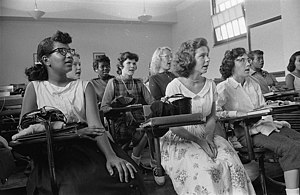
In the United States, school integration (also known as desegregation) is the process of ending race-based segregation within American public and private schools. Racial segregation in schools existed throughout most of American history and remains an issue in contemporary education. During the Civil Rights Movement school integration became a priority, but since then de facto segregation has again become prevalent.[1]
School segregation declined rapidly during the late 1960s and early 1970s.[2] Segregation appears to have increased since 1990.[2] The disparity in the average poverty rate in the schools whites attend and blacks attend is the single most important factor in the educational achievement gap between white and black students.[3]
- ^ "Brown at 62: School Segregation by Race, Poverty and State — the Civil Rights Project at UCLA".
- ^ a b Reardon, Sean; Owens, Ann (2014). "60 Years AfterBrown: Trends and Consequences of School Segregation". Annual Review of Sociology. 40 (1): 199–218. doi:10.1146/annurev-soc-071913-043152. ISSN 0360-0572.
- ^ Reardon, Sean F. (2016). "School Segregation and Racial Academic Achievement Gaps". RSF: The Russell Sage Foundation Journal of the Social Sciences. 2 (5): 34–57. doi:10.7758/RSF.2016.2.5.03. ISSN 2377-8253.
© MMXXIII Rich X Search. We shall prevail. All rights reserved. Rich X Search
